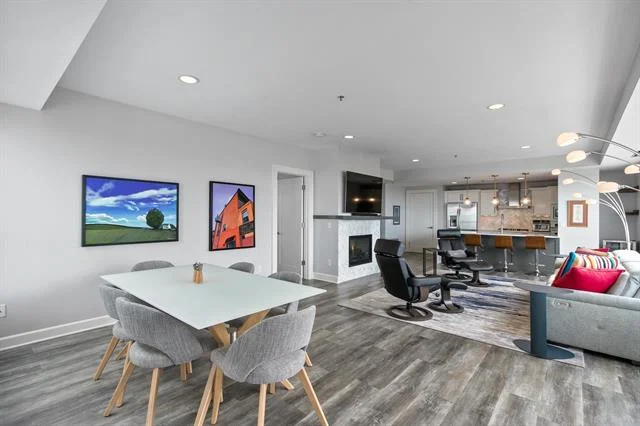If you live somewhere lacking in outdoor space, you might think that means you can’t grow the garden of your dreams. But you don’t have to have a backyard to grow your own food—you just need a sunny window and the patience to wait for your future produce to sprout and grow! There are plenty of vegetables and even some fruits that you can grow indoors (even in a small, city apartment), from salad greens and scallions to peppers, tomatoes, and strawberries.
According to Bonnie Plants, there are a few keys to successfully growing vegetables indoors. For one, you need a spot to grow them that gets plenty of sunlight. That spot also needs to be the right temperature for plants to thrive in, meaning you want to avoid both cold, drafty areas (most veggies need warmer environments to grow!) and keep them away from heat vents and fireplaces that could overheat them and dry them out, or sunlight that’s too direct and could burn your plants. It’s also important to choose containers that have good drainage, to use high-quality potting soil, and of course, to water them regularly and watch out for any pests or plant diseases.
How much sunlight your plants needs depends on what you’re growing—lettuce and herbs, for instance, require less sun, according to Bonnie Plants, but any plants that bear fruit (like a pepper plant) will need quite a bit more light. The good news is, if you don’t have a super-sunny spot to let your indoor edible garden thrive, you can get some help from grow lights—and that goes beyond your vegetable garden and works on your standard houseplants, too. (Oh, and hot tip: If you want to get serious about your indoor vegetable garden or plants in general but don’t like the look of standard grow lights, GE makes grow lights that look like regular light bulbs. You can buy them on Amazon.)
Ready to grow your own indoor edible garden and harvest your own fruits and vegetables? These plant ideas are here to help you get started.
1. Herbs
They’re not quite vegetables, but growing your own herbs is both a step up from buying them at the store and a good first step for your indoor garden, especially if you’re new to gardening entirely. Plus, they’ll make everything else you cook taste so much better. You can plant them as seeds on your own (or use one of these easy grow kits from UncommonGoods) or buy a starter plant from your local garden store.
2. Scallions
Scallions are such a versatile food, and they’re a good option for anyone who wants to start indoor gardening but wants something more low-maintenance and quick-growing. And you have options for growing them, too—you can grow them from seeds, or regrow them from the scraps of scallions you’ve just used in a recipe. To regrow them, all you need is a cup of water and some sunlight, according to TODAY. You can also do the same with leeks!
3. Microgreens
An adorable (and tasty) little addition to salads and perfect for garnishes, microgreens—typically miniature greens from radishes, mustard greens, chard, broccoli, lettuce, and more—can easily be grown at home so long as you have a sunny place to perch them. Just make sure you put them in a shallow container, Bonnie Plants advises.
4. Celery
According to The Old Farmer’s Almanac, celery is another plant you can regrow from food scraps. If you don’t want to grow celery from seeds, just plant the stump (make sure it’s about two inches long) from a bunch root-side-down in either a container of water or a small amount of potting soil after you’ve used the stalks, and soon new growth will start forming from the center.
5. Lettuce
If you love a good salad, you might want to start growing your own greens indoors, too. Lettuce, spinach, swiss chard, kale—they’re all possibilities for your indoor garden, according to Bonnie Plants. For some of them, The Old Farmer’s Almanac notes that you can even follow the same process as regrowing celery, so long as you have a stump to work with.
6. Peppers
Smaller peppers, like chili peppers, shishitos, and more, can be grown inside too, according to Bonnie Plants. To successfully cultivate these colorful, tasty veggies, you’ll again need to designate a spot in a bright, sunny window, since they thrive better outdoors. And if you’re new to indoor gardening and want some extra help growing peppers, you can try this windowsill pepper planter from Back to the Roots.
7. Tomatoes
No, you’re not limited to growing tomatoes outdoors—you can totally grow a tomato plant inside. You just need a spot that gets plenty of sunlight, big enough pots, and stakes or cages to keep the branches upright as they grow. You’ll also want to stick to dwarf tomatoes that are easier to grow in containers, according to Bonnie Plants.
8. Carrots
Carrots are another great option for indoor gardening, especially since they generally prefer cooler environments anyway. You just have to make sure you use the right container, since carrots are a root vegetable. According to Bonnie Plants, that means choosing a pot that’s plenty deep to allow give the plants’ roots space to grow.
9. Radishes
You already know you can grow radish microgreens indoors, but you can grow full-on radishes inside, too. They’re a root vegetable, much like carrots, and they also prefer cooler environments (again, great for indoor gardening!) and require a deep pot for proper growing.
10. Strawberries
Your indoor edible garden doesn’t have to be limited to just herbs and vegetables—you can throw some fruit into the mix with a strawberry plant, too! According to Millcreek Gardens, they’re fairly easy to plant and grow. The only tricky part? Since you won’t have bees visiting your indoor garden, you might need to pollinate your strawberries on your own.
11. Lemons
It might surprise you to see lemons on this list, but yes, you can grow lemon trees indoors. Your best bet is to buy an existing Meyer Lemon tree to cultivate rather than planting seeds, and so long as you have a bright, sunny spot (they need 8-12 hours of sun every day, according to Food52) and take time to mist it, you’ll be growing your own lemons in no time.
12. Mushrooms
Since mushrooms are a fungus and not your typical plant, growing them is a different process, but you can totally grow them indoors. WikiHow has instructions for two ways to grow your own mushrooms at home. Or you can try a grow kit: The one pictured here grows on a log from UncommonGoods and Back to the Roots makes a mushroom grow kit as well.






